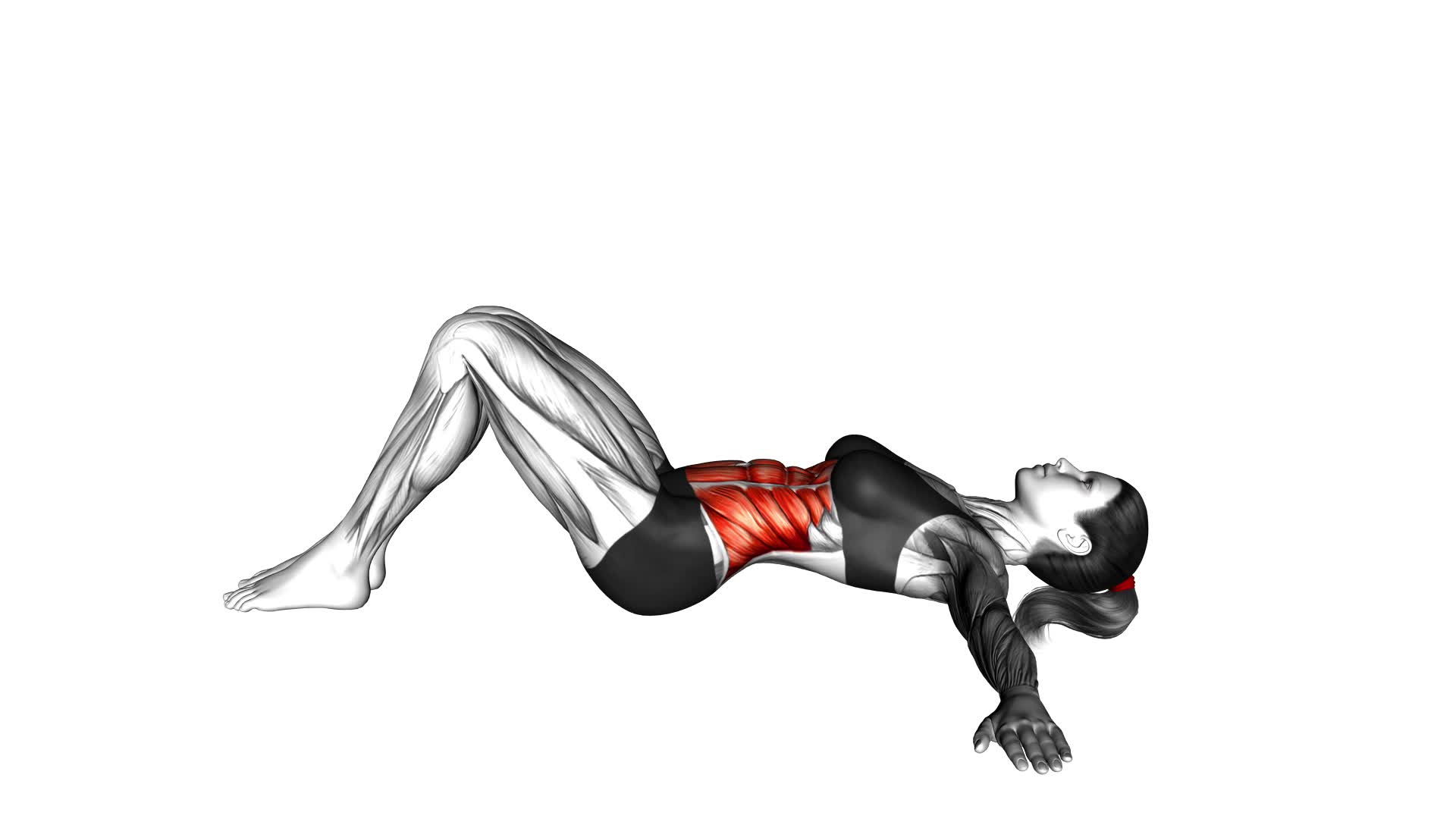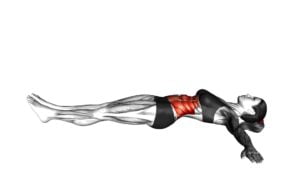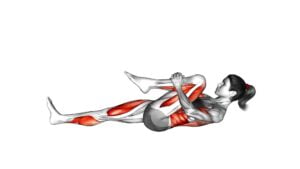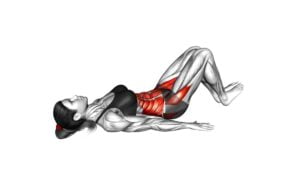Lying Lower Back Stretch (Bent Knee) (Female) – Video Exercise Guide & Tips

Get ready to relieve tension in your lower back with the lying lower back stretch. This video exercise guide is designed specifically for females and provides step-by-step instructions for proper form and technique.
Watch This Exercise Video
Whether you're a beginner or advanced fitness enthusiast, modifications are available to suit your fitness level. Avoid common mistakes and maximize the benefits of this stretch with expert tips.
Incorporate the lying lower back stretch into your routine for a stronger, more flexible back.
Key Takeaways
- The lying lower back stretch improves posture and strengthens the muscles in the lower back.
- It relieves lower back pain and reduces the risk of developing back problems.
- Proper form and technique, such as engaging the core and maintaining a neutral spine position, are important for maximizing the benefits of the stretch.
- Deep breathing and relaxation techniques can enhance the stretch and promote overall relaxation.
Benefits of the Lying Lower Back Stretch
You can experience various benefits from incorporating the lying lower back stretch into your exercise routine. This stretch is effective in improving posture and relieving lower back pain. By regularly performing this stretch, you can strengthen the muscles in your lower back, which helps to support your spine and promote better alignment. This can lead to improved posture and reduce the risk of developing back problems in the future.
Additionally, the lying lower back stretch helps to release tension and tightness in the muscles of the lower back. This can provide immediate relief for those experiencing lower back pain, allowing them to move more freely and comfortably. As you stretch and lengthen the muscles in your lower back, it can also help to increase flexibility, making it easier to perform other exercises and movements.
To perform the lying lower back stretch, lie on your back with your knees bent and feet flat on the floor. Slowly bring one knee towards your chest, using your hands to gently pull it in. Hold this position for about 30 seconds, then switch to the other leg. Repeat this stretch 3-5 times on each side.
Incorporating the lying lower back stretch into your exercise routine can offer significant benefits in terms of improving posture and relieving lower back pain. Make sure to consult with a healthcare professional to ensure this stretch is appropriate for you, especially if you have any pre-existing conditions or injuries.
Proper Form and Technique
To ensure proper form and technique during the lying lower back stretch, it's important to maintain a neutral spine position and engage the core muscles throughout the exercise. Here are three key points to keep in mind:
- Breathing techniques: As you perform the lying lower back stretch, focus on deep, diaphragmatic breathing. Inhale deeply through your nose, allowing your abdomen to rise, and exhale slowly through your mouth, releasing any tension or stress. This controlled breathing can help promote relaxation and enhance the stretch.
- Relaxation techniques: To maximize the benefits of the lying lower back stretch, it's essential to relax your body and mind. As you hold the stretch, consciously release any tension in your muscles and let go of any racing thoughts. You can visualize the tension melting away and imagine yourself sinking deeper into the stretch with each breath.
- Core engagement: Throughout the exercise, remember to engage your core muscles. This means contracting your abdominal muscles and drawing your belly button in towards your spine. By keeping your core activated, you provide stability and support to your lower back, allowing for a more effective and safe stretch.
By following these guidelines for proper form and technique, you can optimize the benefits of the lying lower back stretch.
Now, let's explore modifications for different fitness levels.
Modifications for Different Fitness Levels
When it comes to modifying the lying lower back stretch (bent knee) exercise for different fitness levels, there are a few key points to consider.
For beginners looking to increase flexibility, you can start by bending your knees less and keeping your feet closer to your body.
As you progress, you can gradually increase the bend in your knees and move your feet further away for a deeper stretch.
Advanced variations of this exercise include straightening your legs completely or even lifting your upper body off the ground for an added challenge.
Beginner Modifications for Flexibility
Enhancing flexibility through modified exercises caters to varying fitness levels. For beginners looking to improve their flexibility, there are specific modifications that can be made to ensure a safe and effective workout.
Here are three beginner progressions for stretches targeting tight muscles:
- Standing Forward Bend with Bent Knees: This modification allows individuals with tight hamstrings to still benefit from a forward bend stretch. By bending the knees, the focus is shifted to the lower back and hips, providing a gentler stretch.
- Seated Forward Fold with a Strap: For individuals with tight hamstrings or limited flexibility, using a strap can help deepen the stretch in a seated forward fold. By looping the strap around the feet and gently pulling, you can gradually increase flexibility over time.
- Modified Child's Pose: This modification is perfect for individuals with tight hips or limited mobility. Instead of bringing the hips all the way back to the heels, keep them slightly lifted off the ground, allowing for a more accessible stretch.
Advanced Variations for Challenge
For advanced individuals seeking to further challenge their fitness levels, there are additional modifications that can be incorporated into the lying lower back stretch (bent knee) exercise.
These advanced modifications provide variations for flexibility and help to intensify the stretch. One option is to extend one leg straight while keeping the other knee bent. This increases the stretch in the lower back and hamstrings.
Another modification involves crossing one ankle over the opposite knee, creating a figure-four shape. This targets the hip muscles and adds an extra challenge to the stretch.
Additionally, you can try holding onto a resistance band and pulling it gently towards your chest while performing the stretch. This adds resistance and enhances the overall effectiveness of the exercise.
Remember to listen to your body and only perform these advanced variations if you feel comfortable and ready for the challenge.
Common Mistakes to Avoid
To ensure proper form and effectiveness, be mindful of these common mistakes during the lying lower back stretch:
- Not engaging the core: It's crucial to engage your core muscles throughout the stretch to support your lower back and avoid injuries. By actively contracting your abdominal muscles, you stabilize your spine and create a solid foundation for the stretch.
- Overarching the lower back: Avoid excessive arching of the lower back during the stretch. While some arching is natural, overdoing it can strain the muscles and lead to discomfort or injury. Focus on maintaining a neutral spine position to protect your lower back.
- Rushing the stretch: Take your time and avoid rushing through the exercise. Hold the stretch for the recommended duration to allow your muscles to lengthen and increase flexibility. Rushing can compromise the effectiveness of the stretch and limit its benefits.
Tips for Maximizing the Stretch
To maximize the stretch during the lying lower back stretch, it's important to focus on proper form techniques. Make sure to keep your knees bent and your feet flat on the ground, allowing your lower back to relax and stretch.
Additionally, practicing deep breathing and relaxation techniques can help enhance the effectiveness of the stretch and promote greater flexibility and tension release in the lower back muscles.
Proper Form Techniques
Position your hips and knees in a bent position to maximize the stretch during the lying lower back stretch exercise. Proper form techniques are essential to ensure that you're getting the most out of your stretch and avoiding common misconceptions. Here are three tips to help you achieve proper form and alignment:
- Keep your lower back flat on the ground: This will help target the muscles in your lower back and prevent any strain on your spine.
- Engage your core: Activating your core muscles will provide stability and support during the stretch.
- Relax your shoulders: It's important to keep your shoulders relaxed and avoid tensing them up, as this can hinder the effectiveness of the stretch.
By maintaining proper form and alignment, you can optimize the benefits of the lying lower back stretch.
Now, let's move on to breathing and relaxation techniques to enhance your stretching routine.
Breathing and Relaxation Techniques
Engaging your breath and practicing relaxation techniques can amplify the effectiveness of the lying lower back stretch, allowing for a deeper release of tension and increased flexibility.
Deep breathing is an essential component of maximizing the stretch. As you exhale, focus on letting go of any stress or tension in your lower back. Inhale deeply, filling your lungs with air, and as you exhale, imagine your breath flowing into and out of the tight muscles in your back, helping to relax and lengthen them.
Progressive muscle relaxation can also enhance the stretch. Start by tensing and then releasing each muscle group in your body, from your toes to your head. This technique helps to promote overall relaxation and can improve the effectiveness of the stretch.
Incorporating the Lying Lower Back Stretch Into Your Routine
Start incorporating the lying lower back stretch into your routine for improved flexibility and reduced lower back pain. This stretch, which can be done using the bent knee variation, is an effective way to target the muscles in your lower back and provide relief from discomfort. By incorporating this stretch into your routine, you can enjoy the benefits of increased flexibility and decreased lower back pain.
Here are three ways you can incorporate the lying lower back stretch into your routine:
- Start your day with the lying lower back stretch to wake up your muscles and promote spinal alignment.
- Take breaks throughout the day to perform the stretch, especially if you have a sedentary job or spend a lot of time sitting.
- Include the lying lower back stretch in your post-workout routine to help prevent muscle tightness and promote recovery.
By incorporating yoga poses and stretching exercises into your routine, you can improve your overall flexibility and strengthen the muscles in your back. This can help alleviate back pain and prevent future discomfort.
Remember to listen to your body and only stretch to a comfortable level. As with any new exercise, it's important to consult with a healthcare professional before incorporating the lying lower back stretch into your routine.
Frequently Asked Questions
Can I Perform the Lying Lower Back Stretch if I Have a History of Lower Back Pain?
If you have a history of lower back pain, it's important to be cautious when performing exercises. You may want to consider modifying the lying lower back stretch to suit your needs.
Consult with a healthcare professional or a qualified trainer who can guide you on the appropriate modifications. It's crucial to prioritize your safety and avoid exacerbating any existing conditions.
How Long Should I Hold the Stretch for Maximum Benefit?
To get maximum benefit from the lying lower back stretch, hold the position for about 30 seconds to a minute. This will allow your muscles to stretch and relax.
Beginners can modify the stretch by placing a foam roller under their knees for added support.
Doing this stretch regularly can improve flexibility, relieve lower back pain, and promote better posture.
Don't forget to consult with a healthcare professional before starting any exercise routine, especially if you have a history of lower back pain.
Can Men Also Benefit From Performing the Lying Lower Back Stretch?
Yes, men can definitely benefit from performing the lying lower back stretch. It isn't limited to just women. This stretch helps to improve flexibility in the lower back, which is important for both genders.
However, if you're looking for alternative back stretches, there are many options available that can target different areas of the back. It's important to find stretches that work best for your specific needs and goals.
Is It Normal to Feel Discomfort in the Hips or Glutes During the Stretch?
Feeling discomfort in the hips or glutes during a stretch is normal. It could be a sign that your hip mobility needs improvement or that your form needs adjustment.
To ensure proper form, make sure your back is flat on the ground and your knees are bent at a comfortable angle.
If the discomfort persists or becomes painful, it's best to consult with a professional to avoid any potential injuries.
Can I Perform the Lying Lower Back Stretch if I Am Pregnant?
Yes, you can still perform the lying lower back stretch if you're pregnant. However, it's important to make modifications to ensure your safety and comfort.
It's recommended to use a pregnancy modification such as placing a pillow or bolster under your belly for support.
Additionally, you may want to explore alternative stretches that are more suitable for pregnancy, such as cat-cow pose or seated forward fold.
Always consult with your healthcare provider before starting any new exercise routine during pregnancy.
Conclusion
Incorporating the lying lower back stretch into your routine can provide numerous benefits. This stretch is known for improving flexibility, reducing lower back pain, and promoting relaxation. To maximize the effectiveness of this exercise, it's important to follow proper form and technique. Additionally, modifying the stretch to suit your fitness level and avoiding common mistakes can help prevent injury. Remember to listen to your body and consult a professional if you experience any discomfort. Make this stretch a regular part of your routine to support a healthy and strong lower back.

Author
Years ago, the spark of my life’s passion ignited in my mind the moment I stepped into the local gym for the first time. The inaugural bead of perspiration, the initial endeavor, the very first surge of endorphins, and a sense of pride that washed over me post-workout marked the beginning of my deep-seated interest in strength sports, fitness, and sports nutrition. This very curiosity blossomed rapidly into a profound fascination, propelling me to earn a Master’s degree in Physical Education from the Academy of Physical Education in Krakow, followed by a Sports Manager diploma from the Jagiellonian University. My journey of growth led me to gain more specialized qualifications, such as being a certified personal trainer with a focus on sports dietetics, a lifeguard, and an instructor for wellness and corrective gymnastics. Theoretical knowledge paired seamlessly with practical experience, reinforcing my belief that the transformation of individuals under my guidance was also a reflection of my personal growth. This belief holds true even today. Each day, I strive to push the boundaries and explore new realms. These realms gently elevate me to greater heights. The unique combination of passion for my field and the continuous quest for growth fuels my drive to break new ground.







